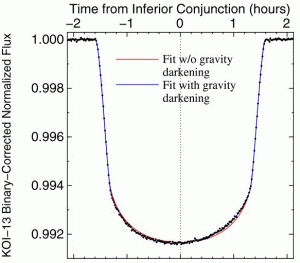
Titan transiting its oblate fluid planet (Credit: HST)
We have previously looked at modelling the transit of an extrasolar planet incorporating limb darkening. How can we build upon this? For starters, it would be nice to actually take into consideration more physical phenomena – nature is not always simple. Take for example the case of a non-spherical star. Consider the case of Saturn, whose rapid rotation distorts the planet away from a spherical shape and more into an oblate shape. Stars, being fluid bodies like gas giant planets, are subject to similar physics, and have measurable effects on the transit light curve.
How does this affect a system? A rotating fluid body like a gas giant planet or a star is subject to centrifugal force which causes the equatorial radius to be larger than the polar radius. This effect, called oblateness, can be measured with
Where a is the equatorial radius and b is the polar radius. In the case of Saturn, the oblateness is about 0.1. Despite a higher rotational velocity, Jupiter’s higher density and surface gravity are able to keep it’s oblateness lower, but still noticeable, at about 0.06. All of the other planets have very different, non-gas-dominated compositions, and have much a lower oblateness (in all cases, less than 0.025). The sun, however, with it’s high surface gravity (28 times that of Earth) and long rotation period (about a month), is almost perfectly spherical, with an oblateness of 0.000009.
In the case of a self-luminous body like a star, oblateness will cause the surface gravity and therefore surface temperature of the star to be a function of latitude. Parts of the surface closer to the poles will be hotter than those near the equator which are pushed further from the stellar centre due to the centrifugal force imposed by the stellar rotation. The temperature of the surface at a given latitude, θ, is given by
Where Tg and Tp are the surface gravity and temperature at the pole, respectively, and β is the gravity darkening coefficient, which much like limb-darkening coefficients, are dependent on the properties of the star and will have to be tinkered with to get a good fit.
An example of this comes from the nearby and well-known rapidly rotating, A-type star Altair, which has been spatially resolved using interferometry, allowing for the construction of a low-resolution temperature map.

Altair (Source)
Notice the oblateness of Altair is greater than even that of Saturn. This has a strong effect on the surface temperature of the star, with the equator being over 1,000 K cooler than the poles!
Much like in the case of limb-darkening, gravity-darkening will cause the luminosity profile of the stellar disc to be concentrated in one particular area. Unlike the case of limb-darkening, however, this area need not be the centre of the disc, but could instead be anywhere on the disc. This allows for transit light curves to actually be asymmetric in the case of a misaligned planetary orbit. A transiting planet in a polar orbit of a gravity-darkened star with, for example, a 45 degree rotation axis inclination, will have its planet occulting the bright polar region before moving over the more equatorial regions, causing the minima of the transit light curve to be displaced from the transit centre over toward the ingress.
Consider for example the case of KOI-13, a rapdily rotating A-type star, much like Altair, which was discovered to have a transiting hot Jupiter by the Kepler mission.
 KOI-13 Light Curve (Source) |
You may need to click on the light curve to expand it to full size to see the slight difference between the gravity-darkened and non-gravity-darkened model. If nothing else, the residuals to the non-gravity-darkened model are clear that the star is not uniformly luminous.
The stars where gravity darkening will be most pronounced will of course be the stars which have high absolute rotation rates. While a high v sin Istar implies a rapid rotation, the converse is not necessarily true since the stellar inclination angle is not known a priori. However, because a gravity-darkened star appears rotationally symmetric when viewed pole-on, the effects it has on the transit light curve are greatly diminished for low values for v sin Istar. This conspires to mean that the stars for which gravity-darkening effects on the light curves of transiting planets will be those stars where Doppler spectroscopy is less effective. Thus, while the Rossiter-McLaughlin effect may not be measurable due to the stellar spectral line broadening and corresponding lack of radial velocity precision, one can still in some cases use gravity-darkening to determine the projected stellar obliquity (or misalignment between the planetary orbit axis and stellar spin axis, however one chooses to interpret the system). Your typical system for which this is applicable is a bloated hot Jupiter transiting a rapidly rotating A-type star, and at present, only a couple such such systems are known.
From the perspective of modelling, gravity darkening is essentially asymmetric limb-darkening. This post was designed to give you the idea behind gravity darkening of stars and how it can affect the light curve for a transiting planet. In a future post, we will look at modelling transiting planets orbiting gravity-darkened stars.
